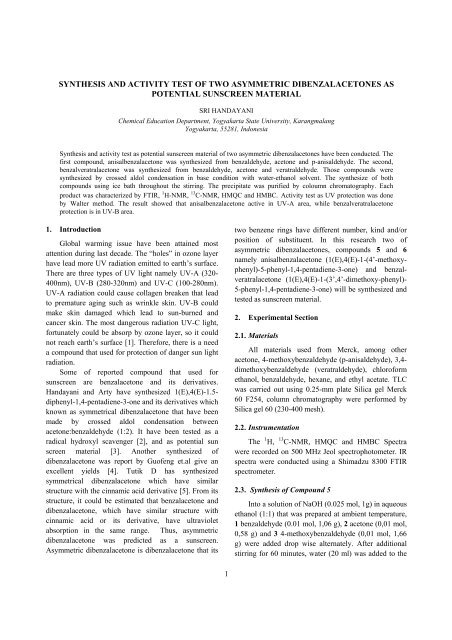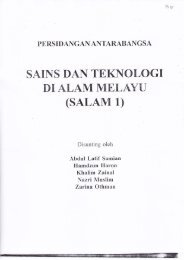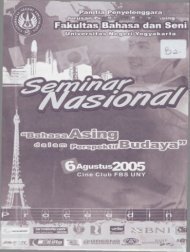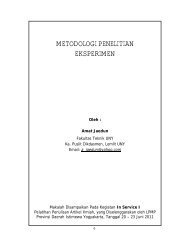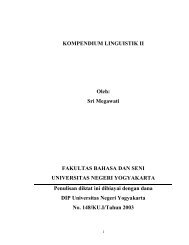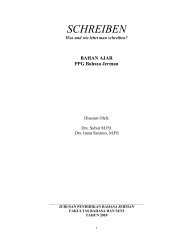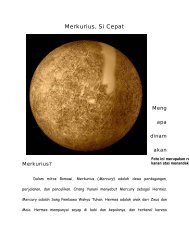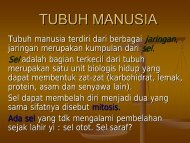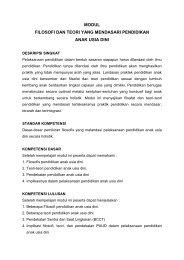synthesis and activity test of two asymmetric ... - Staff UNY
synthesis and activity test of two asymmetric ... - Staff UNY
synthesis and activity test of two asymmetric ... - Staff UNY
Create successful ePaper yourself
Turn your PDF publications into a flip-book with our unique Google optimized e-Paper software.
SYNTHESIS AND ACTIVITY TEST OF TWO ASYMMETRIC DIBENZALACETONES AS<br />
POTENTIAL SUNSCREEN MATERIAL<br />
SRI HANDAYANI<br />
Chemical Education Department, Yogyakarta State University, Karangmalang<br />
Yogyakarta, 55281, Indonesia<br />
Synthesis <strong>and</strong> <strong>activity</strong> <strong>test</strong> as potential sunscreen material <strong>of</strong> <strong>two</strong> <strong>asymmetric</strong> dibenzalacetones have been conducted. The<br />
first compound, anisalbenzalacetone was synthesized from benzaldehyde, acetone <strong>and</strong> p-anisaldehyde. The second,<br />
benzalveratralacetone was synthesized from benzaldehyde, acetone <strong>and</strong> veratraldehyde. Those compounds were<br />
synthesized by crossed aldol condensation in base condition with water-ethanol solvent. The synthesize <strong>of</strong> both<br />
compounds using ice bath throughout the stirring. The precipitate was purified by coloumn chromatography. Each<br />
product was characterized by FTIR, 1 H-NMR, 13 C-NMR, HMQC <strong>and</strong> HMBC. Activity <strong>test</strong> as UV protection was done<br />
by Walter method. The result showed that anisalbenzalacetone active in UV-A area, while benzalveratralacetone<br />
protection is in UV-B area.<br />
1. Introduction<br />
Global warming issue have been attained most<br />
attention during last decade. The “holes” in ozone layer<br />
have lead more UV radiation emitted to earth’s surface.<br />
There are three types <strong>of</strong> UV light namely UV-A (320-<br />
400nm), UV-B (280-320nm) <strong>and</strong> UV-C (100-280nm).<br />
UV-A radiation could cause collagen breaken that lead<br />
to premature aging such as wrinkle skin. UV-B could<br />
make skin damaged which lead to sun-burned <strong>and</strong><br />
cancer skin. The most dangerous radiation UV-C light,<br />
fortunately could be absorp by ozone layer, so it could<br />
not reach earth’s surface [1]. Therefore, there is a need<br />
a compound that used for protection <strong>of</strong> danger sun light<br />
radiation.<br />
Some <strong>of</strong> reported compound that used for<br />
sunscreen are benzalacetone <strong>and</strong> its derivatives.<br />
H<strong>and</strong>ayani <strong>and</strong> Arty have synthesized 1(E),4(E)-1.5-<br />
diphenyl-1,4-pentadiene-3-one <strong>and</strong> its derivatives which<br />
known as symmetrical dibenzalacetone that have been<br />
made by crossed aldol condensation between<br />
acetone:benzaldehyde (1:2). It have been <strong>test</strong>ed as a<br />
radical hydroxyl scavenger [2], <strong>and</strong> as potential sun<br />
screen material [3]. Another synthesized <strong>of</strong><br />
dibenzalacetone was report by Gu<strong>of</strong>eng et.al give an<br />
excellent yields [4]. Tutik D has synthesized<br />
symmetrical dibenzalacetone which have similar<br />
structure with the cinnamic acid derivative [5]. From its<br />
structure, it could be estimated that benzalacetone <strong>and</strong><br />
dibenzalacetone, which have similar structure with<br />
cinnamic acid or its derivative, have ultraviolet<br />
absorption in the same range. Thus, <strong>asymmetric</strong><br />
dibenzalacetone was predicted as a sunscreen.<br />
Asymmetric dibenzalacetone is dibenzalacetone that its<br />
<strong>two</strong> benzene rings have different number, kind <strong>and</strong>/or<br />
position <strong>of</strong> substituent. In this research <strong>two</strong> <strong>of</strong><br />
<strong>asymmetric</strong> dibenzalacetones, compounds 5 <strong>and</strong> 6<br />
namely anisalbenzalacetone (1(E),4(E)-1-(4’-methoxyphenyl)-5-phenyl-1,4-pentadiene-3-one)<br />
<strong>and</strong> benzalveratralacetone<br />
(1(E),4(E)-1-(3’,4’-dimethoxy-phenyl)-<br />
5-phenyl-1,4-pentadiene-3-one) will be synthesized <strong>and</strong><br />
<strong>test</strong>ed as sunscreen material.<br />
2. Experimental Section<br />
2.1. Materials<br />
All materials used from Merck, among other<br />
acetone, 4-methoxybenzaldehyde (p-anisaldehyde), 3,4-<br />
dimethoxybenzaldehyde (veratraldehyde), chlor<strong>of</strong>orm<br />
ethanol, benzaldehyde, hexane, <strong>and</strong> ethyl acetate. TLC<br />
was carried out using 0.25-mm plate Silica gel Merck<br />
60 F254, column chromatography were performed by<br />
Silica gel 60 (230-400 mesh).<br />
2.2. Instrumentation<br />
The 1 H, 13 C-NMR, HMQC <strong>and</strong> HMBC Spectra<br />
were recorded on 500 MHz Jeol spectrophotometer. IR<br />
spectra were conducted using a Shimadzu 8300 FTIR<br />
spectrometer.<br />
2.3. Synthesis <strong>of</strong> Compound 5<br />
Into a solution <strong>of</strong> NaOH (0.025 mol, 1g) in aqueous<br />
ethanol (1:1) that was prepared at ambient temperature,<br />
1 benzaldehyde (0.01 mol, 1,06 g), 2 acetone (0,01 mol,<br />
0,58 g) <strong>and</strong> 3 4-methoxybenzaldehyde (0,01 mol, 1,66<br />
g) were added drop wise alternately. After additional<br />
stirring for 60 minutes, water (20 ml) was added to the<br />
1
2<br />
reaction mixture which then filtered. The extract was<br />
washed with water (20 ml x 3) <strong>and</strong> separated by column<br />
chromatography (d 2.5 cm, h 50 cm), with silica gel 60<br />
(230-400 mesh) as the stationary phase <strong>and</strong><br />
ethylacetate-hexane 1 : 9 as the eluent. The target<br />
compound (5) was identified using thin layer<br />
chromatography with ethylacetate-hexane 5:1 as the<br />
mobile phase.<br />
2.4. Synthesis <strong>of</strong> Compound 6<br />
The similar procedure was repeated for 3,4-<br />
dimethoxybenzaldehyde to replace 4-<br />
methoxybenzaldehyde in order to synthesize compound<br />
6 (Figure 1). Four fractions obtained from the column<br />
chromatography, <strong>and</strong> the target compound was<br />
identified using thin layer chromatography with<br />
chlor<strong>of</strong>orm-hexane 4: 6.<br />
2.5. In Vitro Test as Potential Sunscreen Material<br />
Activity <strong>test</strong> as sunscreen using in vitro method<br />
have been done by : Sample was dissolved in ethanol by<br />
various concentration 0f 1-50 ppm. The concentration<br />
<strong>of</strong> 1 ppm was used to measure optimum wavelength.<br />
The absorbances all variation concentration solution<br />
have been measured at optimum wavelength between<br />
240-400 nm. The SPF (Sun Protection Factor) can be<br />
calculated following Walter formula as<br />
SPF = 10 A (1)<br />
Where A = absorbance <strong>of</strong> each solution. SPF level<br />
<strong>and</strong> UV light type could be determined, also C value<br />
which related to concentration that gives ultra<br />
protection at more than SPF 15.<br />
3. Result <strong>and</strong> Discussion<br />
Separation <strong>of</strong> crossed aldol condensation product<br />
between benzaldehyde, acetone <strong>and</strong> 4-methoxybenzaldehyde<br />
was done by coloumn chromatography.<br />
The product from coloumn chromatography separation<br />
yielded 3 fractions, which were identified by TLC with<br />
hexane-ethylacetate 5:1 as the eluent. Retardation factor<br />
datas from TLC scanner showed that fraction II was the<br />
target <strong>of</strong> compound 5 (10,6%) determined as yellow<br />
residue. Fraction I <strong>and</strong> fraction II supposed to be<br />
benzalacetone <strong>and</strong> dianisalacetone as the side products<br />
<strong>of</strong> crossed aldol condensation reaction.<br />
Figure 1: Scheme <strong>of</strong> cross aldol condensation to synthesized <strong>of</strong><br />
compound 5 <strong>and</strong> 6.<br />
Characterization <strong>of</strong> compound 5 by FTIR (KBr)<br />
resulted peaks on 3035; 2922; 2842; 1668; 1423; 1446;<br />
<strong>and</strong> 1175 cm -1 . A series <strong>of</strong> one <strong>and</strong> <strong>two</strong> dimensional<br />
NMR spectroscopic experiment using HMQC <strong>and</strong><br />
Heteronuclear Multitiple Bond Coherence (HMBC)<br />
patterns were performed to assign the proton <strong>and</strong> carbon<br />
resonance correlation <strong>of</strong> the com compounds. The<br />
signal pattern <strong>of</strong> the aromatic ring showed the influence<br />
<strong>of</strong> methoxy (OMe) in δ 3,8 (3H, s) ppm (Figure 1;<br />
Table 1). Therefore compound 5 is (1(E),4(E)-1-(4’-<br />
methoxyphenyl)-5-phenyl-1,4-pentadiene-3-one) or<br />
anisalbenzalacetone.<br />
The preparation <strong>of</strong> compound 6 was initiated by the<br />
mixing <strong>of</strong> 1, 2 <strong>and</strong> 4 to give 6 (Figure 1). The yield <strong>of</strong><br />
crossed aldol condensation between acetone, 3,4-<br />
dimethoxybenzaldehyde <strong>and</strong> benzaldehyde was a<br />
mixture consist <strong>of</strong> 4 compounds. It was separated by<br />
Column Chromatography (AcOEt-hexane, 1:9) to<br />
provide the <strong>asymmetric</strong> dibenzalacetone 6 (15,53%)<br />
determined as pale yellow oil.<br />
The multiple bond correlation <strong>of</strong> HMBC supported<br />
the structure (Figure 1; Table 2). In the 1 H-NMR<br />
spectrum (500 MHz, CDCl 3 ), <strong>two</strong> patterns singlet, nine<br />
doublet <strong>and</strong> three double dublet were observed. The<br />
double dublet at δ = 7,2; 7,61; <strong>and</strong> 7,41 was assignable<br />
to H2”, H3” <strong>and</strong> H6” respectively. Two equivalence<br />
methoxy signals at δ 3,91 <strong>and</strong> 3,9 were assigned to C3’<br />
<strong>and</strong> C4’. Support spectra data provided by the IR (KBr),<br />
which indicates the existence <strong>of</strong> C=O (1645cm -1 ),<br />
aromatic C=C (1514-1417 cm -1 ) <strong>and</strong> CO ether (1255-<br />
1139 cm -1 ). Therefore, the structure <strong>of</strong> 6 was 1(E),4(E) -<br />
1-(3’,4’-dimethoxyphenyl)-5-phenyl-1,4-pentadiene-3-<br />
one or benzalveratralacetone.
3<br />
Table 1. 1 H, 13 C-NMR <strong>and</strong> HMBC datas <strong>of</strong> compound 5 (CDCl 3 )<br />
C no. Δ H (∑H; m) ppm δ C ppm HMBC (500 MHz)<br />
1<br />
7,70 (1H; d)<br />
143<br />
C6’’, C2,C3<br />
2<br />
6,97 ( 1H; d)<br />
123,4<br />
C3, C2’<br />
3<br />
-<br />
189<br />
-<br />
4<br />
7,07 (1H; d)<br />
125,7<br />
C3, C1”<br />
5<br />
7,74 (1H; d)<br />
143,3<br />
C3<br />
2’,6’<br />
7,58 (2H; d)<br />
129<br />
C1, C3’, C4’<br />
3’,5’<br />
6,93 (2H; d)<br />
114,6<br />
C4’<br />
4’ OMe<br />
3,8; ( 3H, s)<br />
56<br />
C4’<br />
4’<br />
-<br />
162<br />
-<br />
2”<br />
7,61 (1H; d)<br />
130,3<br />
C5, C6”<br />
3”,5”<br />
7,4 (2H; d)<br />
127,6<br />
C4”, C2”<br />
4’’<br />
7,41 (1H; d)<br />
128,5<br />
C1”, C2”<br />
6’’<br />
7,62 (2H; d)<br />
130,5<br />
C5, C2”<br />
Table 2 . 1 H, 13 C-NMR <strong>and</strong> HMBC datas <strong>of</strong> compound 6 (CDCl 3 )<br />
C no. δH (∑H; m) ppm δC ppm HMBC (500 MHz)<br />
1<br />
2<br />
3<br />
4<br />
5<br />
2’<br />
3’<br />
3’ OMe<br />
4’<br />
4’ OMe<br />
5’<br />
6’<br />
2”<br />
3”<br />
4”<br />
5”<br />
6’’<br />
7,69 (1H; d)<br />
143,6<br />
6,94 ( 1H; d)<br />
-<br />
124<br />
188<br />
7,10 (1H; d)<br />
125,6<br />
7,74 (1H; d)<br />
143<br />
7,06 ( 1H; d)<br />
-<br />
110<br />
151<br />
3,9 ( 3H; s)<br />
-<br />
56<br />
150<br />
3,91 (3H; s)<br />
56<br />
6,83 (1H; d)<br />
111<br />
6,89 (1H; d)<br />
120<br />
7,61 (1H; dd)<br />
130<br />
7,2 (1H; dd)<br />
123,4<br />
7,14 (1H; d)<br />
110<br />
7,33 (1H; d)<br />
129<br />
7,41 (1H; dd) 128<br />
C2,C3<br />
C3<br />
-<br />
C3, C1”<br />
C3<br />
C3’<br />
-<br />
C4’<br />
-<br />
C3’<br />
C4’, C6’, C1’<br />
C1’, C5’, C4’<br />
C5<br />
C1”, C4”<br />
C3”<br />
C1”<br />
C1”<br />
Anisalbenzalacetone (5) showed absorbance at UV-<br />
A area (λmax 350 nm). Minimal concentration <strong>of</strong> this<br />
compound that can give ultra protection is 15 ppm at<br />
SPF 26 (Figure 2). Benzalveratralacetone (6) absorb<br />
radiation at UV-B area (λmax 303 nm). Minimal
4<br />
concentration <strong>of</strong> this compound for ultra protection is<br />
30 ppm at SPF 16,143 (Figure 3).<br />
Between those compounds, 5 more potential use as<br />
sunscreen, because it can give more SPF value at lower<br />
concentration than 6.<br />
Figure 2: SPF vs C <strong>of</strong> compound 5<br />
[1] Moloney F.J., Collins S., Murphy G.M., 2002,<br />
Am.J.Clin.Dermatol., 3(3), 185-191<br />
[2] H<strong>and</strong>ayani, S. <strong>and</strong> Arty, I.S., 2008, Journal <strong>of</strong><br />
Physical Science, 19(2), 61-68<br />
[3] H<strong>and</strong>ayani, S., <strong>and</strong> Arty I.S, “Synthesis <strong>and</strong> Activity<br />
Test <strong>of</strong> Some Compounds 1,5-diphenyl-1,4-<br />
pentadiene-3-one as Potensial Sun Screen Material”,<br />
Proc. Of the 1 st International Seminar on science<br />
<strong>and</strong> Technology (ISSTEC), Yogyakarta, Indonesia,<br />
2009<br />
[4] http://www.chemistrymag.org/cji/2004/061007ne.ht<br />
m<br />
[5] Tutik, D., Oksidasi Anetol dan Kajian Pengaruh<br />
Gugus Metoksi Turunan benzaldehide Terhadap<br />
Reaksi Kondensasi Benzoin dan Aldol Silang,<br />
Master Thesis, Gadjah Mada University, 1996.<br />
[6] http://www.webmd.com/skin-problems-sndtrearments<br />
Figure 3: SPF vs C <strong>of</strong> compound 6.<br />
Figure 2 <strong>and</strong> 3 showed that some concentrations<br />
have absorbance above 3, giving SPF value higher than<br />
1000. Sunscreen with higher SPF rating block slighty<br />
more UV-B rays, but none <strong>of</strong>fers 100% protection [6]<br />
The data from high concentration could not be<br />
conciderate because device condition was not valid to<br />
measure compound with high absorbance. Also, for<br />
commercial application, it prefer minimal concentration<br />
that giving ultra protection.<br />
4. Conclusion<br />
Synthesis <strong>of</strong> <strong>asymmetric</strong> dibenzalacetone through<br />
crossed aldol condensation reaction has been done<br />
successfully. Low yields <strong>of</strong> the product was because<br />
there some other side products <strong>of</strong> the reaction. In this<br />
research, compound 5 more potent as sunscreen than 6<br />
because it can give ultra protection at lower<br />
concentration.<br />
5. Reference


